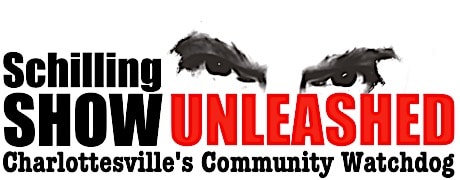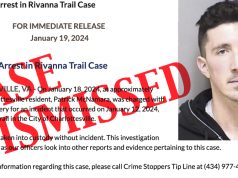 If politics is the art of saying absolutely nothing while using thousands of words, or the craft of staying silent until the last possible minute, Democrat Charlottesville City Councilor, Kristin Szakos, has become a master of the game. In the style of her political hero, “Two-faced Tom” Perriello, Szakos uses double-speak and silence effectively to bamboozle her constituents into believing that she is giving careful thought their input, while in fact, she has long-since made up her mind.
If politics is the art of saying absolutely nothing while using thousands of words, or the craft of staying silent until the last possible minute, Democrat Charlottesville City Councilor, Kristin Szakos, has become a master of the game. In the style of her political hero, “Two-faced Tom” Perriello, Szakos uses double-speak and silence effectively to bamboozle her constituents into believing that she is giving careful thought their input, while in fact, she has long-since made up her mind.
In today’s edition of the Daily Progress, Kristin refuses to comment on her position regarding the Community Water Supply vote that may take place during this evening’s City Council meeting:
Councilor Kristin Szakos, the newest to sit on the five-member body, said all of her questions about the plan have been answered with the stream of findings released over the last few months. In advance of tonight’s public hearing, though, Szakos said she did not want to discuss her thoughts on the water plan and could not predict how the council will vote.
“We just really need to talk about it,” she said.
While the Moat Monster was mum to the press, she bloviated extensively in the following letter to a constituent:
Thanks for sharing your opinions about the Water Plan. It is clear that a lot of people understand the importance of this issue, and the importance of getting it right. I believe strongly in involving as many stakeholders as possible in the decision-making process, and am glad to see that folks are involved.
This Water Plan has had a great deal of public participation over the past several years, with public hearings and meetings, as the possible solutions were narrowed down from several dozen to one. Along the way, and since then, some information changed, new information was requested and received, and other possibilities arose – largely due to the work of concerned citizens like you.
The long-term Water Plan is a complicated issue. Simply framing the decision as dredging or damming, or old pipeline vs. new pipeline misses important issues – like siltation, runoff, environmental regulations, stream flow requirements, abandoned easements that would make maintenance and repair of the old pipeline extremely expensive, and the requirement that we work with our neighbor locality and with UVA, which both plan significant population growth, even if Charlottesville doesn’t.
I do believe we need to respect the process of the years of public participation and decision-making that have already occurred. Those years of public input and public discussion were the means by which the current Plan was crafted, and the basic outline of the Plan has been approved by City Council (in 2006 and in 2008), the Albemarle County Board of Supervisors, and RWSA.
But, like Mayor Norris and other councilors, I believe we need the Plan to reflect the new information we have received in the past year – crafting something that will be acceptable to all parties and be in accordance with state and federal law while being true to our vision for a community committed to respecting and preserving our natural environment and our people.
Here’s what we have learned that necessitates modifications in the Plan:
- We have learned that water demand will likely be considerably less than that anticipated in the initial Plan. Because of the City’s insistence on reflecting conservation, even the most ardent supporters of the Plan agree that the dam could be lowered to 42 rather than 45 feet. I’m confident we will ultimately need less than that.
- We have learned that dredging would be cheaper than originally estimated, especially if we concentrate on the accessible areas with marketable sediment. Although the increased water storage created by this kind of dredging won’t satisfy the worst-case supply projections, it can further delay the day when we need a larger reservoir – if that day ever arrives. (Because it is at the bottom of a large watershed, the South Fork Reservoir will continue to silt in, and should have been maintained with dredging all along. This is one advantage of the Ragged Mountain Reservoir as a long-term water source; sedimentation is not a major issue there.)
- We have learned that the existing Ragged Mountain Dam can be repaired and raised to comply with regional water planning and environmental conservation regulations, apparently more cheaply than a new dam. Before deciding on this option, however, I believe we should look at how much more trucking in of materials would be necessary to repair this dam (concrete) rather than build a new earthen dam of materials already on-site, and what the respective lifetimes of each option would be.
- And most recently, we have learned that there are two possible ways of “phasing” the plan – making possible a larger reservoir later while not having to enlarge it until it is actually needed (if ever). [We have requested an opinion from the EPA as to whether our permit’s environmental requirements could be met with a 13’ raise, or if they would require more height now, but we know that the current required level will be well below 42’.]
- One way is to build a smaller dam now – either through repair of the existing dam or with a new one – in a way that it can be added onto later if the need arises. These additions would, however, require additional expense and the repeated environmental impact of later construction.
- The other is to build a 42-foot dam now (old or new) with an adjustable spillway, with openings at, say, the 13-foot, 30-foot and 42-foot level. These could be set so that the reservoir size could remain at the lowest possible level and be raised only when demand has actually risen. In the short term, this would mean that, regardless of the height of the dam, destruction of trees and hiking areas would not have to be undertaken until additional water supply is actually needed (if ever). With the adjustable spillway, regional leaders will have the larger capacity potential they believe they will need and we can protect our natural resources and encourage conservation.
Some see this issue as the most important that will face our current Council. While it is certainly important (and expensive), I’d urge everyone to look around in our community to see kids who aren’t getting an education, adults who can’t find work, families without housing, and a community divided by race and class to realize that we have a lot of important issues to work on together. I hope you will stay involved.
Still to be decided is the exact formula of cost sharing for the project. Since it is necessitated largely by anticipated growth in the County and at UVA, we should insist that a commensurate proportion of cost is borne by those entities.
I hope that through our discussion on Monday night, City Council will arrive at a proposal that best meets the needs of city residents, our greater community, and our environment. The best we can do is honestly and diligently decide how best to move forward. That’s why we were elected. I trust that you will see the effects of your work in the outcome and realize that without your participation, this plan would not have been as good as it will ultimately be.
Some see this issue as the most important that will face our current Council. While it is certainly important (and expensive), I’d urge everyone to look around in our community to see kids who aren’t getting an education, adults who can’t find work, families without housing, and a community divided by race and class to realize that we have a lot of important issues to work on together. I hope you will stay involved.
Szakos makes no commitment here, but a careful between-the-lines reading of her missive indicates that she likely will vote with Councilor David “Marionette” Brown, in favor of the 2006 water supply “plan,” in spite of possible negative consequences to the Charlottesville ratepayer and taxpayer. Add to this the “plan’s” support by Charlottesville Democrat party-boss (and Szakos campaign manager), Jim Nix, and you have a recipe for an almost certain “yes” vote from Councilor Szakos—who in spite of her attempts to obfuscate, now has been exposed.







